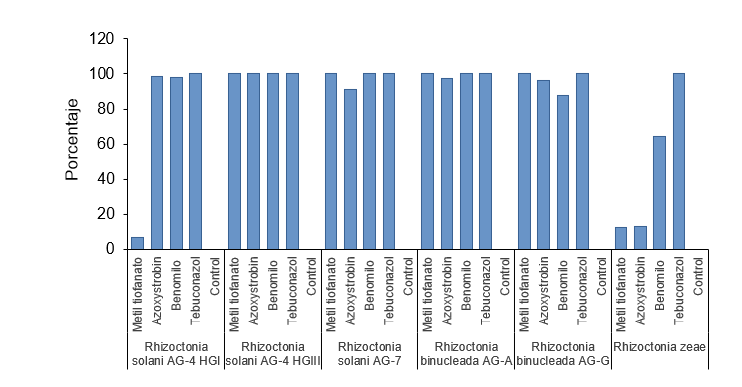Sensitivity of bean and corn Rhizoctonia species to chemical fungicides
DOI:
https://doi.org/10.29312/remexca.v16i7.3836Keywords:
fungicides, resistance, rhizoctoniasis, tebuconazoleAbstract
In the northern region of Sinaloa, the fungus Rhizoctonia spp. causes plants to dry and rot in beans and corn, affecting germination, growth, and roots. This weakens and causes death in plants. Farmers often seek to mitigate the disease by applying chemical fungicides; however, the effectiveness of these treatments is often limited. This is due to inappropriate selection of fungicides, incorrect dosing during application, and pathogens’ potential acquired resistance to these compounds, among other factors. The purpose of this study was to evaluate the in vitro sensitivity of Rhizoctonia isolates from beans and corn to four synthetic fungicides (Azoxystrobin, Benomyl, Methyl thiophanate and Tebuconazole). A completely randomized design was performed, using the commercial dose of each fungicide and a control, with three replications per treatment. The conventional fungicide tebuconazole proved to be the most effective against all Rhizoctonia species evaluated, inhibiting growth by 100%. Effectiveness tests on the sensitivity of Rhizoctonia isolates to fungicides allow us to know the variability of behavior and facilitate the monitoring of isolates that present resistance to fungicides in the pathogen population. This is essential for the development of effective control strategies for Rhizoctoniasis.
Downloads
References
Alburqueque, A. D. y Gusqui, M. R. 2018. Eficacia de fungicidas químicos para el control in vitro de diferentes fitopatógenos en condiciones controladas. Arnaldoa. 25(2):489-498. http://doi.org/10.22497/arnaldoa.252.25209.
FRAC. 2024. Fungicide resistance action committee. Fungicide Resistance Management Home.
González, D. 2013. Identification, molecular characterization, and evolution of group I introns at the expansion segment D11 of 28S rDNA in Rhizoctonia species. Fungal Biology. 117(9):623-637. https://doi.org/10.1016/j.funbio.2013.06.006.
Hernández-Pérez, D.; Díaz-Castellanos, M.; Quiñones-Ramos, R.; Santos-Bermúdez, R.; Portal-González, N. y Herrera-Isla, L. 2018. Control de Rhizoctonia solani en frijol común con rizobacterias y productos naturales. Revista Centro Agrícola. 45(2):55-60.
Little, T. M. y Hills, F. J. 1989. Métodos estadísticos para la investigación en la agricultura. Ed. trillas 2a edición. México, DF. 125-143 pp.
Muzhinji, N.; Woodhall, J. W.; Truter, M. and Van-Waals J. E. 2018. Variation in fungicide sensitivity among Rhizoctonia isolates recovered from potatoes in south Africa. Plant Disease. 102(8):1520-1526. pdis-09-17-1470-re.
Perdomo, R. D.; Hernández, A. J.; González, A. D.; Pineda, J. B. y Alezones, J. M. 2007. Caracterización y evaluación de virulencia en aislamientos de Rhizoctonia solani Kühn, causante de la mancha bandeada en maíz. INCI. 32(1):48-54.
Pérez-Rodríguez, L. R.; Pérez-Moreno, L.; Guzmán-Mendoza, R.; Sanzón-Gómez, D. y Belmonte-Vargas, J. R. 2019. Sensibilidad in vitro de hongos fitopatógenos causantes de enfermedades en fresa a controladores biológicos y fungicidas, en el estado de Guanajuato, México. Acta Universitaria. 29:1-11. https://doi.org/10.15174/au.2019.2339.
Rabago-zavala, K.; Valenzuela-Escoboza, B. E.; Lizarraga-Sánchez, G. J. and Valenzuela-Escoboza, F. V. 2024. Morphological, molecular and pathogenic caracterization of Rhizoctonia solani isolate associated whit been drying in Northern Sinaloa, Mexico. AgroProductividad. 17(11):253-261. https://doi.org/10.32854/agrop.v17i11.3143.
Yang, Y. G.; Zhao, C.; Guo, Z. J. and Wu, X. H. 2015. Characterization of a new anastomosis group (AG-W) of Binucleate Rhizoctonia, causal agent for potato stem canker. Plant Disease. 99(12):1757-1763. https://doi.org/10.1094/PDIS-01-15-0036-re.

Published
How to Cite
Issue
Section
License
Copyright (c) 2025 Revista Mexicana de Ciencias Agrícolas

This work is licensed under a Creative Commons Attribution-NonCommercial 4.0 International License.
The authors who publish in Revista Mexicana de Ciencias Agrícolas accept the following conditions:
In accordance with copyright laws, Revista Mexicana de Ciencias Agrícolas recognizes and respects the authors’ moral right and ownership of property rights which will be transferred to the journal for dissemination in open access. Invariably, all the authors have to sign a letter of transfer of property rights and of originality of the article to Instituto Nacional de Investigaciones Forestales, Agrícolas y Pecuarias (INIFAP) [National Institute of Forestry, Agricultural and Livestock Research]. The author(s) must pay a fee for the reception of articles before proceeding to editorial review.
All the texts published by Revista Mexicana de Ciencias Agrícolas —with no exception— are distributed under a Creative Commons License Attribution-NonCommercial 4.0 International (CC BY-NC 4.0), which allows third parties to use the publication as long as the work’s authorship and its first publication in this journal are mentioned.
The author(s) can enter into independent and additional contractual agreements for the nonexclusive distribution of the version of the article published in Revista Mexicana de Ciencias Agrícolas (for example include it into an institutional repository or publish it in a book) as long as it is clearly and explicitly indicated that the work was published for the first time in Revista Mexicana de Ciencias Agrícolas.
For all the above, the authors shall send the Letter-transfer of Property Rights for the first publication duly filled in and signed by the author(s). This form must be sent as a PDF file to: revista_atm@yahoo.com.mx; cienciasagricola@inifap.gob.mx; remexca2017@gmail.
This work is licensed under a Creative Commons Attribution-Noncommercial 4.0 International license.


